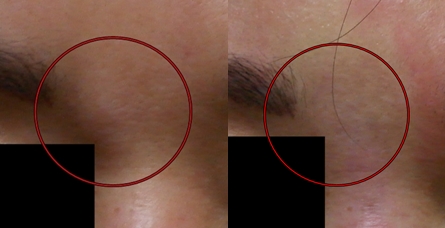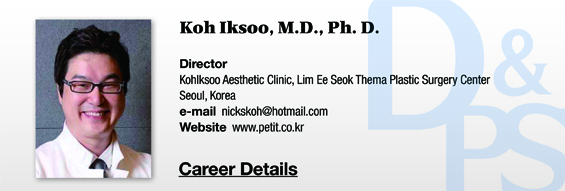Treatment Areas with High Risk of Migration
The facial areas susceptible to dermal filler migration are the forehead and nose. Both hard and soft fillers can migrate in these areas. Soft fillers injected in the forehead is particularly likely to migrate along the movement of expression muscles and creases of the forehead. The forehead wrinkles can often be more pronounced after filler treatment. Therefore, it is necessary to provide muscle correction with botulinum toxin as well. Hard fillers used in the forehead can be shaped more easily and is less likely to be affected by the muscle movement, however, it could create a marked boundary of the injected filler. I advise using a filler with medium hardness in the forehead.
Similarly, using a soft filler in the frontal chin can cause the filler to spread flat due to the impact of the mentalis muscle. In the nose, normal touching or twitching does not cause migration but forceful twisting and pinching with fingers can displace the filler.

Figure 2. The filler injected in the nose is displaced from the patient’s forceful touching.
Solutions to Filler Migration
Most patients will not admit that they touched the treated area. Only about 1 out of 100 patients will be honest about it. In such cases, the doctor can forcibly move the filler to its original place with his hand. If the patient visited soon after the initial migration, it could be corrected with physical force. But if the patient visits a long time after migration, the only option for correction is hyaluronidase. Physical force alone will not be effective as the gap created by a moving filler is already closed.
Inexperienced doctors may think that he is at fault when patients come back complaining of migration. However, with experience, the doctor can tell just by looking at the shape of the displaced filler whether the patient touched the treated area or not. If the patient tried to mold the filler injected in the nose by touching it, the nasion becomes wider, the profile of the nose is distorted or the nasal tip is bulbous.
[Advertisement] MAGNUM(Q-switched Nd:YAG Laser) – Manufacturer: (www.i-dana.com)]
Migration of dermal filler is a common complication. I hope the manufacturers would mention the risk of migration in precautions. It is important for the surgeon to take photographs of the patient before and after treatment and perform a follow-up two weeks after treatment. In my experience, over half of all patients receiving filler procedures cause migration by touching the treatment area. It is important to caution the patient against touching the injection site at the follow-up visit. Excessive touching should be avoided until the filler is completely absorbed. More caution is required with permanent fillers as they could last for up to 10 years.
-To be continued





















